#i was only able to find korean language references to this artist unfortunately but if anybody if curious let me know
Explore tagged Tumblr posts
Text


The Dancheong* Influenced Paintings of Korean Artist Pak Il-Sun.
*Dancheong (단청) is a traditional Korean painting and preservation technique used on wood buildings of religious and cultural significance. The techniques used in Dancheong require years of training, are rich in symbolism and detail, and make use of five primary colors: blue, white, red, black, and yellow.
#bak il sun#art#korean art#박일선#단청#dancheong#korean culture#korean#korean artist#한국#예술#i was only able to find korean language references to this artist unfortunately but if anybody if curious let me know#and i’ll link some articles#tumblr ruins the quality :( sad because these are so rich in detail#jules recommends#findings
119 notes
·
View notes
Text
queen of hearts - sjn
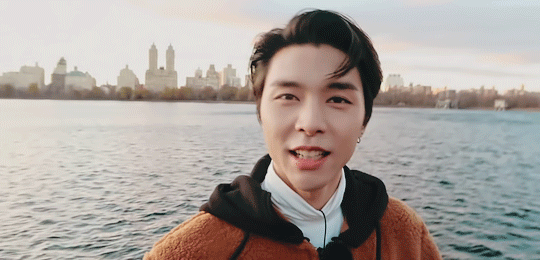
summary: for the first time, one of your star students hasn’t been fetched right after class. but when she finally does, you weren’t expecting such a fine man to be her father.
pairing: johnny x female reader
word count: 5.5k
genre: fluff, romance, comedy | ceo and single dad!johnny + ballerina!reader + modern day!au
warnings: mentions of an absent parent, johnny being an overthinker, sexual innuendos (ten saying dilf hehe), slight explicit language, technical terms of ballet, a mini reference to mean girls
author’s note: sooo i came in touch with my former dance life, which led me to write this. there are links for the variations i used; their names are underlined when they’re mentioned. i am going to get technical with ballet terms here (even when my ballet knowledge decreased), so to any dancers reading, i really did my best, so please don’t come for me or do correct me for any mistakes.
although one character and her dance background, plus the name of the setting, are real, everything else about it is still a work of fiction.
i miss dancing, no cap.
leave me some feedback, constructive criticism or hellos!

Ballet student and teacher by day, a soloist of the Korean National Ballet at night.
This was your daily routine, and it wasn’t the typical 8-5. But it’s debatable whether or not it was worse, because you’re always going overtime. That’s the thing when you’re an overachiever. Nonetheless, you loved what you do. It’s the lifestyle you gradually built since your preschool days.
Mornings on the weekdays were mostly vacant since all the kids were still in school. You’d start at 10 am for a warm-up class for the company. Before you delved into teaching and assisting, you’d train right after your lunch break. Partnering class, en pointe class, 1-on-1 sessions with choreographers, self-practice, then the company night class, that’s the organization of your week.
Now adding the teacher title, you mostly handled kindergartners to 5th graders in the academy aspect of the company. Your first teaching class would start at 1 pm. It’s when the younger students who finished their morning classes zoom into your assigned dance studio. One class would last an hour and a half, then you have a 30-minute break in between another class with the older kids. Their lesson repertoire was more strenuous due to the added across-the-floor lessons and jumps. Water was always your best friend, water refilling stations located everywhere in the company building.
You wouldn’t say you’re a strict teacher, but you weren’t shy to correct anyone from wherever you stood. You’d lightly align their arms or back properly so your students were working on the correct body parts. Compared to the other teachers, a lot of students enjoyed your kind yet frank approaches. Your former students, who’ve already gone to the higher levels, missed your lively presence and wished repeatedly that they want you back as their teacher.
“Teacher (Y/N), I miss you so much! Teacher Ten is so intense. I get the jitters especially when we’re en pointe on the floor.”
“Teacher (Y/N), Teacher Sicheng and Teacher Seulgi scare the heck out of me during partnering class. Especially when I tried to lift my partner, I keep losing focus because of Teacher Sicheng’s never-ending comments!”
Not to be sadistic, but you’d simply laugh at their minuscule complaints. Even if they’re struggling in the academy, those comments were directed to fix their techniques if they wanted to breakthrough.
“Kids, you’re going to be fine! They wouldn’t say or do those things just because they wanted to. They’re here to push you to the next level, like how I used to do with you. It’s a cut-throat industry after all.”
This was always your reply, bittersweet and truthful. Not everyone makes it, unfortunately, so if you’re really striving, you’d do whatever it takes. Throughout your career, you’re relatively impressed with how far you’ve come.
Trainee at 17, Corps de Ballet at 18, Demi-Soloist at 21, and Soloist at 23.
You’ve been a soloist for 4 years. The final stage, which was to become a principal dancer, is your running goal. Becoming a soloist was praiseworthy enough because you’ve seen so many give up in the Corps, but claiming a spot as a principal dancer has been the ultimate dream. Since you’ve watched Swan Lake for the first time at 4 years old with your parents, that’s where you found a passion for dancing and the stage. Here you are years later, practicing numerous variations daily, performing in opera houses, and mentoring all these gifted kids.
Your last class with elementary kids, which began around 5 pm, reached its end once all the students curtsied in front of you and scurried to their mothers or their nannies. The remaining plan on your agenda today was the company class at 7:30 pm, which exceeds the average hour and a half. It’s worse during show season. There have been times everyone went beyond midnight to polish every scene from head to toe.
Currently, there’s no upcoming show for the public, though the annual summer recital for the students was around the corner. Selected members of the company were chosen to perform individually in it, which was both exciting and intense. It’s also because it’s an evaluation on whether you’d get promoted in status or staying put. You’ve partaken in 3 recitals in the past, two of which elevated you from the corps and demi-soloist ranks. The recent one, however, didn’t change your soloist ranking.
It was a major first in your career in ballet, and after finding out the result of the latter, it emotionally pained you. Recalling how much soul you put into that piece, the rejection from your artistic director clenched your heart. Though in time, you moved on from it and viewed it as a stepping stone. Also, Sicheng and Ten personally stormed your apartment to pull yourself together with wine and pizza after going on a short leave.
Since you were trainees, Sicheng and Ten were your best friends in and outside the company. Working daily to occasional barhopping, that’s your youth summed up. It wasn’t because you didn’t like the girls you’ve worked with (though a lot of them were fake and bitchy), but these two were frank and humorous as hell. Together, you’d help each other with your goals rather than be competitive. Over time, Ten leveled up to a principal dancer for 2 years running while you and Sicheng were still soloists. The way you’d watch Ten take all the big roles, that’s where you want to be one day.
Back in your last teaching class, the entire dance room was vacant. Since it’s mainly used for ballet classes, you’d either run through anything you’ve practiced from the company classes and polish it or warm up a little bit more.
Except for today, this was the only free time to sew a new pair of pointe shoes because your current ones were dead. Dead in a sense that the hard shell turned soft, which won’t be able to support you when you’re up on your toes. You’re not taking any risks of minor injuries especially when you’re in the current lineup of company members performing for this upcoming recital again. You have to prove to everyone that you deserve a position as a principal dancer.
As your legs sprawled in a half middle split, your sewing equipment laid in front of you like you’re about to perform surgery, a tiny girl stood by the ajar studio doors. In her neat bun and holding on to her small duffel bag, you’re convinced everyone has gone home already since it’s quite late.
You may have your priorities as a company member, but she was still your student.
“Minji!” You shouted her name, speedily waving your hand. You’re not one to have favorites, though you couldn’t help wonder how extraordinary she was. She’s always taking charge in demonstrating the lessons to everyone and improving every session in the 3 years she’s joined the academy. “Come in! Come in!”
At age 7, she’s gotten taller through the years, above the average from how you see it. She must have amazing genetics. Her legs sauntered in seconds to you. Sitting down across you, she marveled at your setup. Specifically, at the fresh pointe shoes.
“Are those yours, Teacher (Y/N)?” She perked up, caressing its soft fabric and playing with the mini bows of the drawstrings.
“Yes, it is, Minji!” You answered while trying to insert the thin thread through the small eye of the needle. “Why are you still here? Is your nanny stuck in traffic or something?”
“My nanny went on sudden leave, so my dad’s the one fetching me. But I think he’s running late from his job.”
Oh, this was a first to know about her father. In all the years she’s been your student, you rarely caught sight of him, even in recitals. Maybe he sat in an unknown section, but you’re pretty much acquainted with all the parents of your students. Even if some were snobbier than the rest because they wanted their child to have more stage time, you still got to know them out of respect. Quite odd, if you said so yourself.
After deep concentration, the thread triumphantly passed through the eye so you tied the two ends of the thread in a double knot. Seeing as Minji attentively watched you, you tasked her to cut the ribbons of your shoes according to the trail of pencil marks. This was so she wouldn’t cut it too short or too long. While she did that, you hammered your shoes against the floor to soften the hard front, bending the shank back and forth so the arch of your feet could move without difficulty later.
Minji wasn’t expecting such loud sounds, her entire body shaken awake. Her facial expression was priceless, explaining to her, “Once you get your first pointe shoes in a few years, this is one of the basic things you need to do so your feet won’t hurt too much while dancing.”
“Will you be there to teach me how to make my pointe shoes?”
“Absolutely! Come to me first then I’ll mentor you all that I know.”
The process of sewing and breaking new pointe shoes engraved your mind since your adolescent years, with changes along the way. Inspired by some tricks from your former teachers, but there were some differing rituals you followed. There’s no definite process of it, just as long you’re comfortable to dance after.
With your feet, you stepped on the hard boxes of the shoes to soften it more, creating a popping sound. Followed by sewing your elastic bands in. For your ribbons, you liked to burn the edges with a lighter so the thread of it won’t run. Kindly asking your cute assistant for the lighter beside her, you scanned the edges back and forth the flame. In seconds, the edges had a distinct mark, fully closed. From there, you slid your feet to your shoes to make final sewing adjustments. Sewing your ribbons took you another few minutes, plus adding superglue inside the shoe so the shoe won’t collapse when it unstiffens and scratching the shank with a cutter so you won’t slip later while dancing.
Voila, the final product is done! Hopefully, it can last you a week at least.
“Wow, Teacher (Y/N), it looks pretty!” Minji applauded, collecting the mess you’ve both made to dispose of later. You, on the other hand, gave her your thanks once you applied some bandages on your big toes and put on your toe pads. Slipping inside the shoes and tying them, you rose up back to your feet and headed to the bar to break them in. From plies-relevésto forced arches, the shoes gave you the sensation that they were an extension of your feet. The ease flowed through, meaning you were ready to practice your variations.
While you stepped your shoes in rosin for friction, your curious student moved to the front where the mirror lied to watch what you’ve prepared.
“What variation are you dancing to?”
“This is the Gamzatti variation from La Bayadere.” You replied, tapping the play button on your phone and racing to your position on the side. Talking a short ballet walk, you strongly prepared your arms before the music of the orchestra takes off.
This variation consisted of a lot of jumps and turns. Grand jetés, attitude turns, chaîné turns, you needed a lot of core control and proper spotting so you won’t get dizzy. The thrilling music lessened your nerves because you enjoyed learning this piece from one of the principal dancers, smiling and letting the music guide your legs. Once you nailed 3 consecutive grand jetés, the variation ended with a sus-sous and the wrists of your hands flicking upwards.
Holding it for 5 more seconds, you landed back on your feet with heavy breathing and a need for water. But before you could, small claps and cheers from Minji in front erupted. Momentarily, you’ve forgotten her presence because dancing solo puts you in your own space. You’d never let anyone take you away from it.
“Teacher (Y/N), that was wonderful! Are you performing that in the summer recital?”
Yikes, she’s right but she wasn’t meant to see it yet. Solo performances from the company members for the recital were top secret, only unveiled during the production rehearsal. Well, you didn’t think this through, but you didn’t mind.
“Can you keep a secret?”
Time ticked a lot faster today, only 10 minutes left until the company class on the ground floor whereas you were in the second. Just a few steps down the stairs away, yet Minji was still here. You only presumed that within your hour break, her father could’ve made it already. But maybe he’s stuck in traffic or at work.
“Minji, my class starts soon. Have you contacted your father?”
“I already texted him earlier, but he hasn’t responded. This happens often, he’s a busy man.” She bowed in front of you suddenly. “I’m sorry, Teacher (Y/N) for the hassle.”
“Oh no, please!” You shook your hands so she’d stop. Because this situation was relatively new, you were unsure of how to handle it. Or that was until you remembered what Ten texted you earlier. “Minji, the blinds of the main studio are going to be lifted so anyone from the outside can view us practicing. Would you like to watch until your dad gets here?”
With her insistent nodding, she situated herself in one of the seats in the front row. When you entered the main studio, your two close companions already carried a metal barre to the center and leaned towards it while observing you walking to them in your flat shoes.
“I see we have a bit of an audience here.” Ten glimpsed at the young girl, astonished by the many dancers prepping and chatting away with their cliques from the glass barrier.
“Her dad isn’t here yet, and you did say the blinds were up today. Might as well give her a show while she waits, you know.” You lifted your right leg to the top barre, stretching it with your arms.
“Hmmm, shouldn’t her dad be more cautious though? It’s getting late and it’s a Thursday. Doesn’t she have school or something?” Sicheng pointed out, discarding his muscle tee to straighten out his leotard.
“That’s not my business though. She’s just my student, and since she’s still here, I have to entertain her while she waits.”
Before your friends said anything back, the artistic director of the ballet company strutted her way to the center of the room. It’s a common rule here that once she entered, everyone must be silent to listen and race to any free spot in the numerous barres spread out if they haven’t.
“Alright, everyone. We’ll do the typical barre, then before doing across the floor exercises, I’ll be requesting those performing solos already in the recital to dance any variation tonight as another evaluation on who deserves to perform twice.” She eyed the pianist directly beside her. “Proceed first with two demi-pliés then one grand plié. Don’t forget to do the port de bras of each position.”
As the live piano music played, your focus was divided. Partly properly executing the exercise while your artistic director roamed each barre area, partly thinking about what variation to perform. This was a first for the company, and everyone was just stunned to hear the breaking news. It’d be nice to get an extra opportunity to showcase to people your potential.
30-40 minutes flew by quickly. As the guys carried the bars to the side to clear out the floor and the girls changed to their pointe shoes, the artistic director ordered all the performers of the recitals to stand in a line in front of her. Everyone else was seated around the room, so the interested eyes of everyone were on you. There were 10 performers, half are from the corps and the other half are either demi-soloists or soloists. You and Sicheng stood beside each other, internally shaking with nerves under the intimidating eyes of the artistic director. She used to be a principal dancer for the Stuttgart Ballet in Germany before moving back to Seoul, making her undeniably capable of leading all of you.
“Okay,” From her seated position observing the 10 performers, her finger pointed at you directly. “Ms. (Y/L/N) (Y/N), you perform first.”
Your nerves intensified and more sweat streamed out your upper body. Even if going first felt more relieving, no one was ever brave enough to perform individually in front of the esteemed artistic director. Principal dancers aside from Ten that you’re close with were intimidated when they have 1-on-1 or partnering sessions with her. But anyhow, in less than 2 minutes, you’d be done. This wasn’t the first time she’s had your full attention either, so you’ll treat it like the other individual performances you’ve had.
You smiled to yourself when the other soloists left you alone, while you gave the name of the variation you’re dancing to the pianist. Running to the side to put on a practice tutu, the artistic director asked, “What will you be dancing for us tonight, (Y/N)?”
“I’ll be dancing Queen of the Dryads from Don Quixote.”
The last time you did this variation was 3 years ago during the recital that didn’t change your position as a soloist. Even if this variation hurt to think about for a while, it was still one of your favorites to watch and do. Moving on, you could only muse how powerful and beautiful you felt at that time. This isn’t an easy piece to perform in your opinion. Yet according to the members of the company, this was their favorite solo of yours.
As the starting notes unfolded, you took a deep breath and elegantly walked into the frame. You only wished you wore your fake crown again for this. Minimal smiling and light arms, you imagined yourself as an actual queen who captured the eyes of many. In this case, your fellow seniors and juniors held their breaths at the captivating sight of you.
Off you go into a series of glissade jeté developpé on relevé at elevating heights, then a fouetté arabesque and another arabesque on relevé before ballet walking again to the side to dance across the stage. Sissonne to the front, right developpé to the front on relevé, pique to prepare for a single pirouette, you gracefully did a chassé to the front twice and stood on your toes with a sus-sous.
Doing it a few more times, the climax of the entire variation was nearing. Returning to the center, you took another deep breath and lifted your left leg for the Italian fouettés. Spotting to the front and back while maintaining your balance, the variation approached its end with lame duck turns, posing with your arms were positioned at a 45-degree angle, your back slightly arched and your left leg doing a tendu derriére. Your eyes reflected at the mirror in front, surveying your alignment. Once your 5-second hold was finished, you properly put your arms down and closed your back leg into 5th position.
The applause from everyone in the room roared, Ten and Sicheng wolf-whistling even for more support. It’s a usual thing every time any of you perform individually, and no one minded it. The artistic director grinned, giving a quiet clap from the front before calling out the next performer, who was from the corps. Bowing to everyone hastily, you paid more attention to spot your student by the window. She was smiling ear to ear, waving both hands at you.
“You did amazing, Teacher!” She mouthed. Hearing words of praise from members was one thing, but hearing them from students was another. You’re so used to watching them and giving them your compliments that you often forget that you’re a dancer first before a teacher. Seeing them all delighted, saying that it motivates them more, showed that you’re doing a great job teaching them. You’re a reflection of what you pass down, and all you want was for them to be the best they could be.
From her jolly expression, a tall masculine silhouette hovered a part of the window. Her instinct of giving a brighter smile when the hand of said silhouette patted her head then carried her duffel bag again, that could only mean one thing. Excusing yourself to the artistic director, you stepped out to bid your goodbye and maybe meet her father. Minji and the tall man were about to leave the building if it weren’t for your breathy voice calling them out.
“Seo Minji and Mr. Seo?”
They stopped their tracks. Minji was fast to react, familiar with your voice and racing towards you for a sweaty hug. Meanwhile, your focus shifted once the masculine silhouette came into full view. You finally understood why Minji’s growth spurt spiked up, noticing that he was taller than Sicheng.
The top buttons of his shirt were off, yet he kept his formal blazer on. His hair was a bit tousled, some strands falling in front of his forehead. He must’ve run here. Peeking through were some roots of his scruff growing. His eyebags were almost as dark as his brown hair. Yet by the way his Rolex remained spotless, you blatantly assumed that he was more than well-off. Especially when the ballet academy was one of the most prestigious ones in Seoul.
Out of all the parents you’ve met, none of them appeared youthful like him.
“Teacher (Y/N)?” Thanks to Minji, you moved your staring eyes away from him. This was another first, since meeting only the fathers of your students wasn’t your norm. Meeting young-looking fathers, to be specific.
“O-Oh,” You ate your words, suddenly blanking out. “You’re leaving me without saying goodbye, Minji? Not polite of you.”
“My father was rushing right after watching your performance, and I don’t know why.” She responded, her finger scratching the top of her head in confusion. Speaking of said father, his strong presence appeared right in front of you. The wrinkles of his forehead creased while his eyes barely looked at yours.
“Uhm,” His fingers toyed with his Rolex. “I apologize for my tardiness. I got caught up in work and all, plus her nanny le-”
“Mr. Seo.” You halted his rambling, already aware of the situation. Like father, like daughter. “It’s fine. Minji loved watching us practice while waiting, and she wasn’t a bother either. You have nothing to worry about.”
“Phew.” He swiped an imaginative bead of sweat from his forehead, displaying his relief with his playful nature.
At age 23, Johnny Seo started his own company in the fashion scene and it grew internationally in the coming years. Then when Minji unexpectedly joined the picture, he’s been multi-tasking to make ends meet. Lately, as a CEO, he has had meetings and conferences on a daily. So, his position as a single father was always tested. It worsened when he rarely has proper time to spend any time with Minji unless it’s the weekend or late in the evening. Breaking it down, it wasn’t because he didn’t want to meet you. It was more like he couldn’t when his schedules were packed from head to toe.
Having the guilt of taking your precious time, “Seriously though, I am sorry for being late. Her nanny resigned suddenly, and I have no time to find her replacement.”
“Mr. Seo, again, don’t worry about it. As her teacher and a company member, I am practically here 24/7 so it won’t be a nuisance at all if this happens again.”
“Thank you so much, Teacher (Y/N). That is your name, right?” He planted his palm on his forehead, stressed. “Being a single parent is hard. I am always forgetting things.”
A part of you couldn’t restrain from feeling sorry for his struggle. Taking care of a child should be the work of both the mother and father, not one of them being absent. You’ve feared this would harm Minji, but she’s a strong girl.
“The fact you didn’t forget to fetch Minji despite the late time is still something to be happy over. I’m not a parent or anything, but parenting, in general, is a challenge.” You added an insight, patting the head of the young girl beside you. “Cut yourself some slack, Mr. Seo. I’m sure Minji still loves you, right?”
Minji shouted a big yes, now clinging to the leg of her father. “It’s okay, dad. Really.”
Over the years, Johnny has been doubtful of his parenting skills. He was an only child, and he struggled to ask for guidance from his own parents due to the shame of having a kid at a young age. So, he’d ask for help from his other friends and co-workers. No matter how many times they’ve reassured him that he’s doing well, he’s an overthinker who always reflected on the bad scenarios. There’s also that pressure to find someone who can fill that absent position not just for Minji, but for himself too. No matter how many girls he’s asked out or been set up with, he failed in the love department badly.
It’s the soothing way you voiced out your truth that made all these negative thoughts running through his head freeze briefly. Over the past 3 years since Minji started ballet, she always had a great story about you to share. One of them was how ballet made her a lot happier because of your influence. If he had at least an hour of his day to meet any of his daughter’s mentors, it would’ve been you.
“Do feel free to call me Johnny instead.” He casually introduced himself, taking his hand out for you to shake. “Mr. Seo makes me feel like I’m at work right now.”
Despite his informal approach, you understood his intentions and returned the action with a promising smile. “Pleasure to finally meet you, Johnny.”
“Pleasure is all mine, Teacher (Y/N).”
Earlier, the nerves from performing in front of the artistic director died down fast. But for some reason, they rose back up when you’ve spoken to this man in a matter of minutes. As someone whose feelings don’t flourish in a single glance, why did this man specifically deliver you such a strong effect?
If it weren’t for Ten calling for your name by the door, you would’ve held on to Johnny’s hand longer, which would’ve been inappropriate. Letting go first, this was your cue to return to your class.
“I must head back inside, Johnny. Don’t sweat on fetching your daughter late, though she is still a student with school the following day. Right, Minji?”
Minji nodded as Johnny kept that mind, knowing where he has to improve next. “Yes, Teacher (Y/N). Thank you again, sincerely. I’ll definitely see you again in the coming days until Minji has a new nanny.”
“That’s no problem with me at all, Johnny.”
Soon as Johnny held his daughter’s hand to exit the studio and you were re-entering the studio with an impatient Ten, he swerved swiftly as if he forgot something.
“Oh by the way Teacher (Y/N), I saw your whole performance awhile ago. I was blown away, you deserved the applause.”
Although you could only distinguish his silhouette, you didn’t suppose he watched you from head to toe. Most parents or nannies would’ve dragged their kids out of the studio once they find them like they were on a tight schedule, so this was novel to experience. That performance showed your prime too.
“Thank you, Johnny. See you again soon.”
Giving a final nod, you led yourself back to the studio, not bothering to acknowledge the erupting heat on your cheeks and entire body. Not to sound narcissistic, but compliments weren’t foreign to you. You’re conscious of the hard work that you put in your talent and if they pointed out your greatness, why would you deny it? However, receiving one from Johnny was like gearing your engine with new fuel.
Before you could try to reject these harboring feelings, Ten was fast to pick up on it. You cannot hide anything from this man at all because body language was like another language he’s fluent in (aside from the other 5). Unlucky for you, the saga continued.
“You’re so into dilfs, (Y/N)!” He shrieked in your ear, nudging your shoulder repetitively. He placed things in his own way, yet they always shocked you because it was so inappropriate. Typical Ten for you.
“Shut up, Ten!” You objected, watching the other performers. You’ve improved in ignoring his remarks over time. That was until Sicheng sat down beside you after his solo and got up in your business. That placed you in the middle of boys from the water sign clan of astrology. They just loved getting down to your love life, going raunchy and whatnot.
“Who’s into dilfs, Ten?”
“A Miss (Y/N) beside you, who met Minji’s dad awhile ago, was basically eye-fucking him.” Ten elaborated, planting his elbows on your leg and gave you a sneaky glare. “Minji’s dad is fine as fuck, guys! I’m telling you, like a literal god! I’m surprised this is the first time he showed up here after 2-3 years?”
“How come (Y/N) is always getting students with good-looking parents? Especially the single moms.” Sicheng slumped his shoulders, attempting to get your attention too. “Is he that hot, (Y/N)?”
“Yah.” Sighing with annoyance, you’ve given up trying to appreciate one of the corps dancers with her rendition of Dulcinea from Don Quixote. “Don’t speak of Johnny like that. You barely know the man, yet you talk about him so unprofessionally."
“Oh, Johnny is his name, huh?” Sicheng sing-songed, bobbing his head. He’s certainly going to stalk him later on social media, you felt it in your chest. Like it was ESPN or something.
“Talking about being unprofessional, yet you’re here referring him as Johnny, not Mr. Seo.” Ten barked back, his lips pursed and one eyebrow lifted.
Just as soon as you could retaliate, the artistic director’s velvety voice boomed the room.
“Alright, thank you to the performers. I will deliberate with the staff and principal dancers over the weekend, and let you know the results on Monday. Now please, let’s proceed to the center.”
Everyone began to spread out on the wide floor, snatching a good position so they could monitor themselves in the mirror. Maybe you’ll defend yourself later after class because now, you needed to beat everyone else and have a crystal-clear view of yourself doing these following exercises.
In the meantime, Johnny was in the middle of driving Minji home. He had a designated chauffeur, but he gave him the night off because he wanted to spend time with Minji. Around this time, she’d be sleeping soundly, but instead, she’s boosting with so much life. She hasn’t even eaten dinner yet, which was the first thing on Johnny’s agenda now.
Playing Coldplay in the car, Minji belted some lyrics from her favorite songs while Johnny smiled to himself while listening to her attentively. Taking a breath, her thoughts reverted to her fantastic ballet teacher and shared them with her father.
“Dad! Don’t you just think Teacher (Y/N) is so cool? Ugh, I want to be just like her when I grow up.”
“Oh, to become a ballerina like her, you have to work hard every day and memorize lessons fast. Are you up for it, Minji?”
“Absolutely, dad! I want to pull off perfect jumps and turns like her one day!”
In the other after-school activities Johnny enrolled Minji in the past, none of them compared to the passion she had for ballet. Her work ethic was alike to Johnny’s: if they want something, they’ll do whatever it takes to make it possible.
Aside from being a star student in her school, she’s aiming to be a star ballerina. Being the supportive father he is, Johnny was on board to do what it takes to make it happen. Unlike his parents trying to mold him into the next heir of their company, he’s all ears to the dreams of his daughter. His only dream for her was to be live long and happy, not to merely pass on anything.
Johnny lost so much in his young life, so he doesn’t want to lose Minji in any way. As much as he loves his profession, he wanted to be an active father as much as time allowed it. He mostly received complaints from others that he’s not prioritizing his time well, but after hearing your kind words, this heavy weight on his shoulders decreased. All this doubt started to vanish after meeting you for the first time.
“Dad! Isn’t Teacher (Y/N) so beautiful?” Minji honored whilst gazing at the twinkling night sky. “She loves what she does and shines at it.”
Johnny was accustomed to his female co-workers throwing themselves at him due to his attractiveness, more than flattered even to have them feeling weak for him. Yes, there were times he used it to his advantage, some he frankly turned down.
However, the radiance you carried whether you’re dancing or not was something Johnny couldn’t cease wondering about. Unknown to him, he’s the one getting weak. Behold, an unlocked first for the confident CEO.
“Yes, Minji. I do think Teacher (Y/N) is absolutely beautiful.”
#nct#nct x reader#nct imagines#nct scenarios#nct angst#nct fluff#nct 127#nct 127 x reader#nct 127 imagines#nct 127 scenarios#nct 127 angst#nct 127 fluff#johnny suh#suh johnny#seo youngho#nct johnny x reader#nct johnny#johnny x reader#johnny angst#johnny fluff#johnny silverhand#nct 127 johnny#johnny suh x reader#johnny suh imagines#johnny suh scenarios
470 notes
·
View notes
Text
Cross-Cultural Design
When I first traveledto Japan as an exchange student in 2001, I lived in northern Kyoto, a blockfrom the Kitayama subway station.
My first time using the train to get to my university was almost a disaster, even though it was only two subway stops away. I thought I had everything I needed to successfully make the trip. I double- and triple-checked that I had the correct change in one pocket and a computer printout of where I was supposed to go in the other. I was able to make it down into the station, but then I just stood at a ticket machine, dumbfounded, looking at all the flashing lights, buttons, and maps above my head (Fig 5.1). Everything was so impenetrable. I was overwhelmed by the architecture, the sounds, the signs, and the language.

Fig 5.1: Kyoto subway ticket machines—with many line maps and bilingual station names—can seem complicated, especially to newcomers.
My eyes cravedsomething familiar—and there it was. The ticket machine had a small button thatsaid English! Ipushed it but became even more lost: the instructions were poorly translated,and anyway, they explained a system that I couldn’t use in the first place.
Guess what saved me?Two little old Japanese ladies. As they bought tickets, I casually looked overtheir shoulders to see how they were using the machines. First, they looked up atthe map to find their desired destination. Then, they noted the fare written nextto the station. Finally, they put some money into the machine, pushed thebutton that lit up with their correct fare, and out popped the tickets! Wow! Itried it myself after they left. And after a few tense moments, I got my ticketand headed through the gates to the train platform.
I pride myself onbeing a third-culture kid, meaning I was raised in a cultureother than the country named on my passport. But even with a cultural upbringing in both Nigeriaand the US, it was one of the first times I ever had to guess my way through atask with no previous reference points. And I did it!
Unfortunately, the same guesswork happens online a million times a day. People visit sites that offer them no cultural mental models or visual framework to fall back on, and they end up stumbling through links and pages. Effective visual systems can help eliminate that guesswork and uncertainty by creating layered sets of cues in the design and interface. Let’s look at a few core parts of these design systems and tease out how we can make them more culturally responsive and multifaceted.
Typography
If you work on theweb, you deal with typography all the time. This isn’t a book about typography—othershave written far more eloquently and technically on the subject. What I wouldlike to do, however, is examine some of the ways culture and identityinfluence our perception of type and what typographic choices designers canmake to help create rich cross-cultural experiences.
Stereotypography
I came across the wordstereotypography a few years ago. Being African, I’m well aware of the way my continent isportrayed in Western media—a dirt-poor, rural monoculture with little in theway of technology, education, or urbanization. In the West, one of the most recognizablegraphic markers for things African, tribal, or uncivilized (and no, they arenot the same thing) is the typeface Neuland. Rob Giampietro calls it “the NewBlack Face,” a clever play on words. In an essay, he asks an importantquestion:
How did [Neuland and Lithos] come to signify Africans and African-Americans, regardless of how a designer uses them, and regardless of the purpose for which their creators originally intended them? (http://bkaprt.com/ccd/05-01/)
From its release in 1923 and continued use through the 1940s in African-American-focused advertising, Neuland has carried heavy connotations and stereotypes of cheapness, ugliness, tribalism, and roughness. You see this even today. Neuland is used in posters for movies like Tarzan, Jurassic Park, and Jumanji—movies that are about jungles, wildness, and scary beasts lurking in the bush, all Western symbolism for the continent of Africa. Even MyFonts’ download page for Neuland (Fig 5.2) includes tags for “Africa,” “jungle fever,” and “primitive”—tags unconnected to anything else in the product besides that racist history.
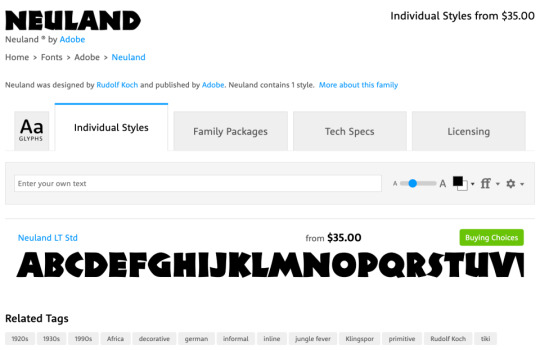
Fig 5.2: On MyFonts, the Neuland typeface is tagged with “Africa”, “jungle fever”, and “primitive”, perpetuating an old and irrelevant typographic stereotype (http://bkaprt.com/ccd/05-02/).
Don’t make, use, orsell fonts this way. Here are some tips on how to avoid stereotypography whendefining your digital experiences:
Be immediately suspicious of any typeface that “looks like” a culture or country. For example, so-called “wonton�� or “chop-suey” fonts, whose visual style is thought to express “Asianness” or to suggest Chinese calligraphy, have long appeared on food cartons, signs, campaign websites, and even Abercrombie & Fitch T-shirts with racist caricatures of Asians (http://bkaprt.com/ccd/05-03/). Monotype’s website, where you can buy a version called Mandarin Regular (US$35), cringingly describes the typeface’s story as “an interpretation of artistically drawn Asian brush calligraphy” (Fig 5.3). Whether or not you immediately know its history, run away from any typeface that purports to represent an entire culture.
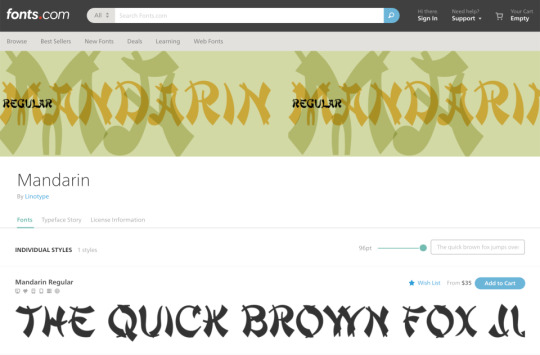
Fig 5.3: Fonts.com sells a typeface called Mandarin Regular with the following description: “The stylized Asian atmosphere is not created only by the forms of the figures but also by the very name of the typeface. A mandarin was a high official of the ancient Chinese empire” (http://bkaprt.com/ccd/05-04/).
Support type designers who are from the culture you are designing for. This might seem like it’s a difficult task, but the internet is a big place. I have found that, for clients who are sensitive to cultural issues, the inclusion of type designers’ names and backgrounds can be a powerful differentiator, even making its way into their branding packages as a point of pride.
The world wide webfont
Another common design toolyou should consider is webfonts—fonts specifically designed for use on websitesand apps. One of the main selling points of webfonts is that instead ofputting text in images, clients can use live text on their sites, which isbetter for SEO and accessibility. Theyare simple to implement these days, a matter of adding a line of code orchecking a box on a templating engine. The easiest way to get them on your siteis by using a service like Google Fonts, Fontstand, or Adobe Fonts.
Or is it? That assumesthose services are actually available to your users.
Google Fonts (and every other service using Google’s Developer API) is blocked in mainland China, which means that any of those nice free fonts you chose would simply not load (http://bkaprt.com/ccd/05-05/). You can work around this, but it also helps to have a fallback font—that’s what they’re for.
When you’re building your design system, why not take a few extra steps to define some webfonts that are visible in places with content blocks? Justfont is one of the first services focused on offering a wide range of Chinese webfonts (http://bkaprt.com/ccd/05-06/). They have both free and paid tiers of service, similar to Western font services. After setting up an account, you can grab whatever CSS and font-family information you need.
Multiple scriptsystems
When your design workrequires more than one script—for instance, a Korean typeface and a Latintypeface—your choices get much more difficult. Designs that incorporate morethan one are called multiple script systems (multiscript systems for short). Combining them is aninteresting design challenge, one that requires extra typographic sensitivity. Luckily,your multiscript choices will rarely appear on the same page together; you willusually be choosing fonts that work across the brand, not that work well nextto one another visually.
Let’s take a look at an example of effective multiscript use. SurveyMonkey, an online survey and questionnaire tool, has their site localized into a variety of different languages (Fig 5.4). Take note of the headers, the structure of the text in the menu and buttons, and how both fonts feel like part of the same brand.


Fig 5.4: Compare the typographic choices in the Korean (http://bkaprt.com/ccd/05-07/) and US English (http://bkaprt.com/ccd/05-08/) versions of SurveyMonkey’s Take a Tour page. Do the header type and spacing retain the spirit of the brand while still accounting for typographic needs?
Some tips as you attempt to choose multiscript fonts for yourproject:
Inspect the overall weight and contrast level of the scripts. Take the time to examine how weight and contrast are used in the scripts you’re using. Find weights and sizes that give you a similar feel and give the page the right balance, regardless of the script.
Keep an eye on awkward script features. Character x-heights, descenders, ascenders, and spacing can throw off the overall brand effect. For instance, Japanese characters are always positioned within a grid with all characters designed to fit in squares of equal height and width. Standard Japanese typefaces also contain Latin characters, called romaji. Those Latin characters will, by default, be kerned according to that same grid pattern, often leaving their spacing awkward and ill-formed. Take the extra time to find a typeface that doesn’t have features that are awkward to work with.
Don’t automatically choose scripts based on superficial similarity. Initial impressions don’t always mean a typeface is the right one for your project. In an interview in the book Bi-Scriptual, Jeongmin Kwon, a typeface designer based in France, offers an example (http://bkaprt.com/ccd/05-09/). Nanum Myeongjo, a contemporary Hangul typeface, might at first glance look really similar to a seventeenth-century Latin old-style typeface—for instance, they both have angled serifs. However, Nanum Myeongjo was designed in 2008 with refined, modern strokes, whereas old-style typefaces were originally created centuries ago and echo handwritten letterforms (http://bkaprt.com/ccd/05-10/). Looking at the Google Fonts page for Nanum Myeongjo, though, none of that is clear (Fig 5.5). The page automatically generates a Latin Nn glyph in the top left of the page, instead of a more representative Hangul character sample. If I based my multiscript font choices on my initial reactions to that page, my pairings wouldn’t accurately capture the history and design of each typeface.
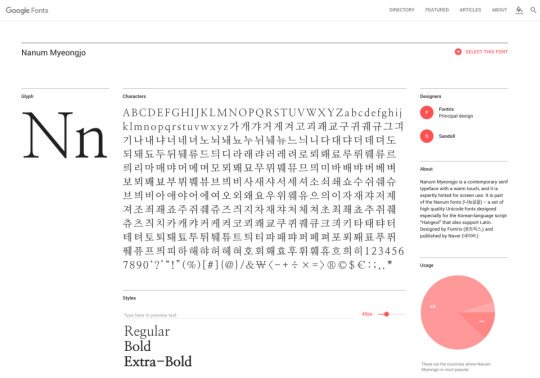
Fig 5.5: The Google Fonts page for Nanum Myeongjo shows a Latin character sample in the top left, rather than a more representative character sample.
Visual density
CSS can help you controlvisual density—how much text, image, and other content there is relative to thenegative space on your page. As you read on, keep cultural variables in mind: differentcultures value different levels of visual density.
Let’s compare what arecommonly called CJK(Chinese, Japanese, Korean) alphabets and Latin (English, French, Italian, etc.) alphabets. CJK alphabetshave more complex characters, with shapes that are generally squarer than Latinletterforms. The glyphs also tend to be more detailed than Latin ones, resultingin a higher visual density.
Your instinct might beto create custom type sizes and line heights for each of your localized pages.That is a perfectly acceptable option, and if you are a typophile, it may driveyou crazy not todo it. But I’m here to tell you that when adding CJK languages to a designsystem, you can update it to account for their visual density without rippingout a lot of your original CSS:
Choose a font size that is slightly larger for CJK characters, because of their density.
Choose a line height that gives you ample vertical space between each line of text (referred to as line-height in CSS).
Look at your Latin text in the same sizes and see if it still works.
Tweak them together to find a size that works well with both scripts.
The 2017 site for Typojanchi, the Korean Typography Biennale, follows this methodology (Fig 5.6). Both the English and Korean texts have a font-size of 1.25em, and a line-height of 1.5. The result? The English text takes up more space vertically, and the block of Korean text is visually denser, but both are readable and sit comfortably within the overall page design. It is useful to compare translated websites like this to see how CSS styling can be standardized across Latin and CJK pages.
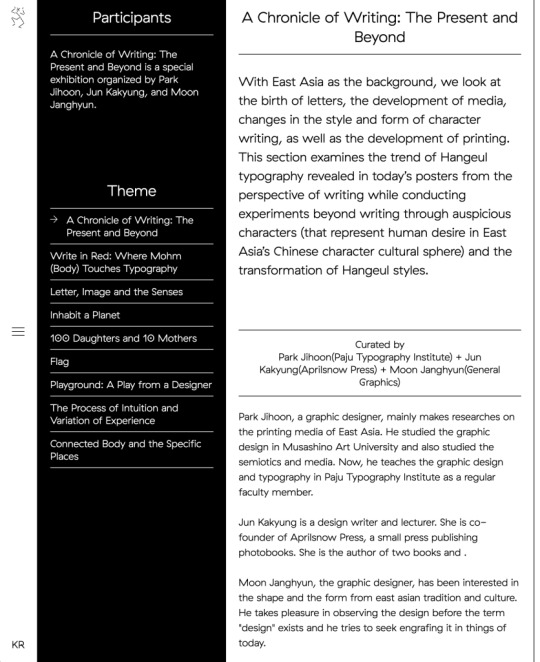
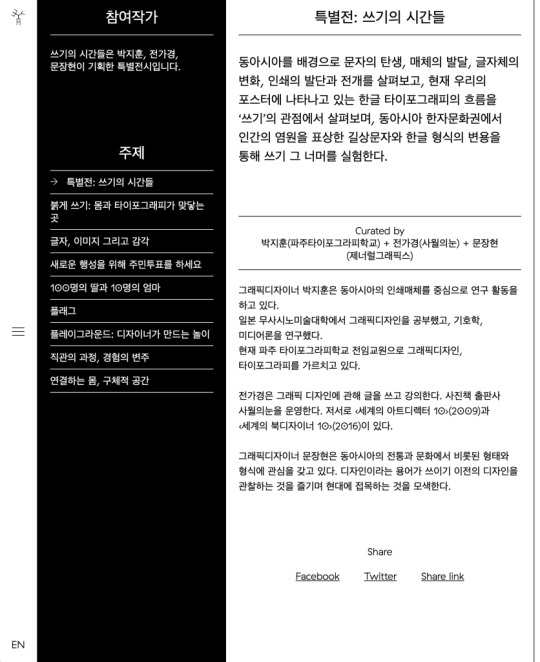
Fig 5.6: The 2017 site for Typojanchi, the Korean Typography Biennale, shows differing visual density in action. It is useful to compare translated websites like this to see how CSS styling can be standardized across Latin and CJK pages (http://bkaprt.com/ccd/05-11/).
Text expansion factors
Expansion factors calculatehow long strings of text will be in different languages. They use either adecimal (1.8) or a percentage (180%) to calculate the length of a text stringin English versus a different language. Of course, letter-spacing depends onthe actual word or phrase, but think of them as a very rough way to anticipate spacefor text when it gets translated.
Using expansion factors is best when planning for microcopy, calls to action, and menus, rather than long-form content like articles or blog posts that can freely expand down the page. The Salesforce Lightning Design System offers a detailed expansion-factor table to help designers roughly calculate space requirements for other languages in a UI (Fig 5.7).
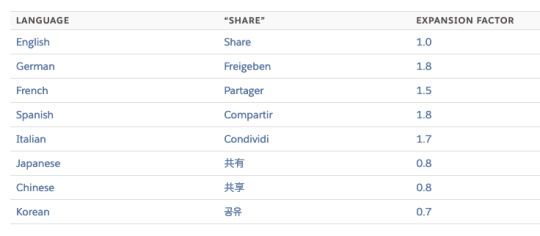
Fig 5.7: This expansion-factor table from Salesforce lets designers and developers estimate the amount of text that will exist in different languages. Though dependent on the actual words, such calculations can give you a benchmark to design with content in mind (http://bkaprt.com/ccd/05-12/).
But wait! Likeeverything in cross-cultural design, nothing is ever that simple. Japanese, forexample, has three scripts: Kanji, for characters of Chinese origin,hiragana, for words and sounds that are not represented in kanji, and katakana,for words borrowed from otherlanguages.
The follow button is a core part of the Twitter experience. It has six characters in English (“Follow”) and four in Japanese (フォロー), but the Japanese version is twenty percent longer because it is in katakana, and those characters take up more space than kanji (Fig 5.8). Expansion tables can struggle to accommodate the complex diversity of human scripts and languages, so don’t look to them as a one-stop or infallible solution.


Fig 5.8: On Twitter, expansion is clearly visible: the English “Follow” button text comes in at about 47 pixels wide, while the Japanese text comes in at 60 pixels wide.
Here are a few thingsyou can do keep expansion factors in mind as you design:
Generate dummy text in different languages for your design comps. Of course, you should make sure your text doesn’t contain any unintentional swearwords or improper language, but tools like Foreign Ipsum are a good place to start getting your head around expansion factors (http://bkaprt.com/ccd/05-13/).
Leave extra space around buttons, menu items, and other microcopy. As well as being general good practice in responsive design, this allows you to account for how text in your target languages expands.
Make sure your components are expandable. Stay away from assigning a fixed width to your UI elements unless it’s unavoidable.
Let longer text strings wrap to a second line. Just ensure that text is aligned correctly and is easy to scan.
0 notes
Text
Cross-Cultural Design
When I first traveled to Japan as an exchange student in 2001, I lived in northern Kyoto, a block from the Kitayama subway station.
My first time using the train to get to my university was almost a disaster, even though it was only two subway stops away. I thought I had everything I needed to successfully make the trip. I double- and triple-checked that I had the correct change in one pocket and a computer printout of where I was supposed to go in the other. I was able to make it down into the station, but then I just stood at a ticket machine, dumbfounded, looking at all the flashing lights, buttons, and maps above my head (Fig 5.1). Everything was so impenetrable. I was overwhelmed by the architecture, the sounds, the signs, and the language.

Fig 5.1: Kyoto subway ticket machines—with many line maps and bilingual station names—can seem complicated, especially to newcomers.
My eyes craved something familiar—and there it was. The ticket machine had a small button that said English! I pushed it but became even more lost: the instructions were poorly translated, and anyway, they explained a system that I couldn’t use in the first place.
Guess what saved me? Two little old Japanese ladies. As they bought tickets, I casually looked over their shoulders to see how they were using the machines. First, they looked up at the map to find their desired destination. Then, they noted the fare written next to the station. Finally, they put some money into the machine, pushed the button that lit up with their correct fare, and out popped the tickets! Wow! I tried it myself after they left. And after a few tense moments, I got my ticket and headed through the gates to the train platform.
I pride myself on being a third-culture kid, meaning I was raised in a culture other than the country named on my passport. But even with a cultural upbringing in both Nigeria and the US, it was one of the first times I ever had to guess my way through a task with no previous reference points. And I did it!
Unfortunately, the same guesswork happens online a million times a day. People visit sites that offer them no cultural mental models or visual framework to fall back on, and they end up stumbling through links and pages. Effective visual systems can help eliminate that guesswork and uncertainty by creating layered sets of cues in the design and interface. Let’s look at a few core parts of these design systems and tease out how we can make them more culturally responsive and multifaceted.
Typography
If you work on the web, you deal with typography all the time. This isn’t a book about typography—others have written far more eloquently and technically on the subject. What I would like to do, however, is examine some of the ways culture and identity influence our perception of type and what typographic choices designers can make to help create rich cross-cultural experiences.
Stereotypography
I came across the word stereotypography a few years ago. Being African, I’m well aware of the way my continent is portrayed in Western media—a dirt-poor, rural monoculture with little in the way of technology, education, or urbanization. In the West, one of the most recognizable graphic markers for things African, tribal, or uncivilized (and no, they are not the same thing) is the typeface Neuland. Rob Giampietro calls it “the New Black Face,” a clever play on words. In an essay, he asks an important question:
How did [Neuland and Lithos] come to signify Africans and African-Americans, regardless of how a designer uses them, and regardless of the purpose for which their creators originally intended them? (http://bkaprt.com/ccd/05-01/)
From its release in 1923 and continued use through the 1940s in African-American-focused advertising, Neuland has carried heavy connotations and stereotypes of cheapness, ugliness, tribalism, and roughness. You see this even today. Neuland is used in posters for movies like Tarzan, Jurassic Park, and Jumanji—movies that are about jungles, wildness, and scary beasts lurking in the bush, all Western symbolism for the continent of Africa. Even MyFonts’ download page for Neuland (Fig 5.2) includes tags for “Africa,” “jungle fever,” and “primitive”—tags unconnected to anything else in the product besides that racist history.
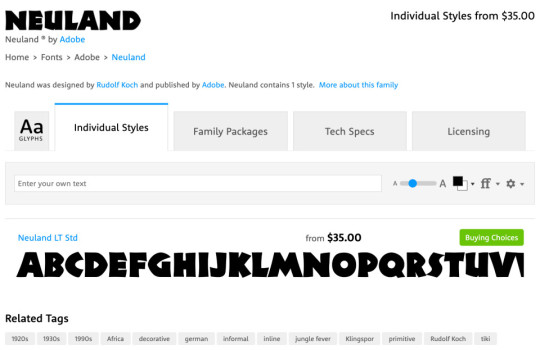
Fig 5.2: On MyFonts, the Neuland typeface is tagged with “Africa”, “jungle fever”, and “primitive”, perpetuating an old and irrelevant typographic stereotype (http://bkaprt.com/ccd/05-02/).
Don’t make, use, or sell fonts this way. Here are some tips on how to avoid stereotypography when defining your digital experiences:
Be immediately suspicious of any typeface that “looks like” a culture or country. For example, so-called “wonton” or “chop-suey” fonts, whose visual style is thought to express “Asianness” or to suggest Chinese calligraphy, have long appeared on food cartons, signs, campaign websites, and even Abercrombie & Fitch T-shirts with racist caricatures of Asians (http://bkaprt.com/ccd/05-03/). Monotype’s website, where you can buy a version called Mandarin Regular (US$35), cringingly describes the typeface’s story as “an interpretation of artistically drawn Asian brush calligraphy” (Fig 5.3). Whether or not you immediately know its history, run away from any typeface that purports to represent an entire culture.
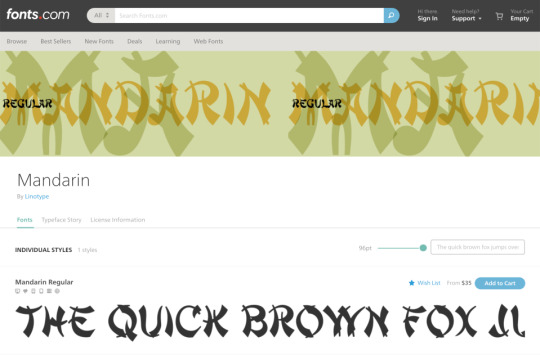
Fig 5.3: Fonts.com sells a typeface called Mandarin Regular with the following description: “The stylized Asian atmosphere is not created only by the forms of the figures but also by the very name of the typeface. A mandarin was a high official of the ancient Chinese empire” (https://ift.tt/2T4LppO).
Support type designers who are from the culture you are designing for. This might seem like it’s a difficult task, but the internet is a big place. I have found that, for clients who are sensitive to cultural issues, the inclusion of type designers’ names and backgrounds can be a powerful differentiator, even making its way into their branding packages as a point of pride.
The world wide webfont
Another common design tool you should consider is webfonts—fonts specifically designed for use on websites and apps. One of the main selling points of webfonts is that instead of putting text in images, clients can use live text on their sites, which is better for SEO and accessibility. They are simple to implement these days, a matter of adding a line of code or checking a box on a templating engine. The easiest way to get them on your site is by using a service like Google Fonts, Fontstand, or Adobe Fonts.
Or is it? That assumes those services are actually available to your users.
Google Fonts (and every other service using Google’s Developer API) is blocked in mainland China, which means that any of those nice free fonts you chose would simply not load (http://bkaprt.com/ccd/05-05/). You can work around this, but it also helps to have a fallback font—that’s what they’re for.
When you’re building your design system, why not take a few extra steps to define some webfonts that are visible in places with content blocks? Justfont is one of the first services focused on offering a wide range of Chinese webfonts (http://bkaprt.com/ccd/05-06/). They have both free and paid tiers of service, similar to Western font services. After setting up an account, you can grab whatever CSS and font-family information you need.
Multiple script systems
When your design work requires more than one script—for instance, a Korean typeface and a Latin typeface—your choices get much more difficult. Designs that incorporate more than one are called multiple script systems (multiscript systems for short). Combining them is an interesting design challenge, one that requires extra typographic sensitivity. Luckily, your multiscript choices will rarely appear on the same page together; you will usually be choosing fonts that work across the brand, not that work well next to one another visually.
Let’s take a look at an example of effective multiscript use. SurveyMonkey, an online survey and questionnaire tool, has their site localized into a variety of different languages (Fig 5.4). Take note of the headers, the structure of the text in the menu and buttons, and how both fonts feel like part of the same brand.


Fig 5.4: Compare the typographic choices in the Korean (http://bkaprt.com/ccd/05-07/) and US English (http://bkaprt.com/ccd/05-08/) versions of SurveyMonkey’s Take a Tour page. Do the header type and spacing retain the spirit of the brand while still accounting for typographic needs?
Some tips as you attempt to choose multiscript fonts for your project:
Inspect the overall weight and contrast level of the scripts. Take the time to examine how weight and contrast are used in the scripts you’re using. Find weights and sizes that give you a similar feel and give the page the right balance, regardless of the script.
Keep an eye on awkward script features. Character x-heights, descenders, ascenders, and spacing can throw off the overall brand effect. For instance, Japanese characters are always positioned within a grid with all characters designed to fit in squares of equal height and width. Standard Japanese typefaces also contain Latin characters, called romaji. Those Latin characters will, by default, be kerned according to that same grid pattern, often leaving their spacing awkward and ill-formed. Take the extra time to find a typeface that doesn’t have features that are awkward to work with.
Don’t automatically choose scripts based on superficial similarity. Initial impressions don’t always mean a typeface is the right one for your project. In an interview in the book Bi-Scriptual, Jeongmin Kwon, a typeface designer based in France, offers an example (http://bkaprt.com/ccd/05-09/). Nanum Myeongjo, a contemporary Hangul typeface, might at first glance look really similar to a seventeenth-century Latin old-style typeface—for instance, they both have angled serifs. However, Nanum Myeongjo was designed in 2008 with refined, modern strokes, whereas old-style typefaces were originally created centuries ago and echo handwritten letterforms (http://bkaprt.com/ccd/05-10/). Looking at the Google Fonts page for Nanum Myeongjo, though, none of that is clear (Fig 5.5). The page automatically generates a Latin Nn glyph in the top left of the page, instead of a more representative Hangul character sample. If I based my multiscript font choices on my initial reactions to that page, my pairings wouldn’t accurately capture the history and design of each typeface.
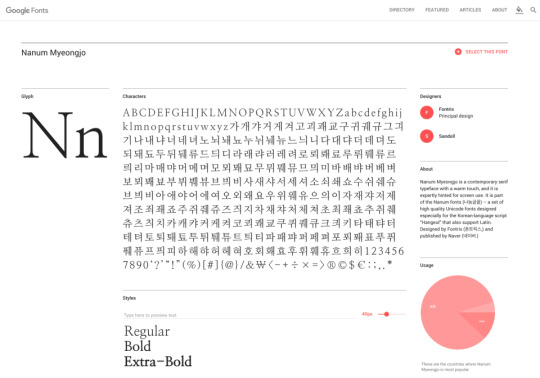
Fig 5.5: The Google Fonts page for Nanum Myeongjo shows a Latin character sample in the top left, rather than a more representative character sample.
Visual density
CSS can help you control visual density—how much text, image, and other content there is relative to the negative space on your page. As you read on, keep cultural variables in mind: different cultures value different levels of visual density.
Let’s compare what are commonly called CJK (Chinese, Japanese, Korean) alphabets and Latin (English, French, Italian, etc.) alphabets. CJK alphabets have more complex characters, with shapes that are generally squarer than Latin letterforms. The glyphs also tend to be more detailed than Latin ones, resulting in a higher visual density.
Your instinct might be to create custom type sizes and line heights for each of your localized pages. That is a perfectly acceptable option, and if you are a typophile, it may drive you crazy not to do it. But I’m here to tell you that when adding CJK languages to a design system, you can update it to account for their visual density without ripping out a lot of your original CSS:
Choose a font size that is slightly larger for CJK characters, because of their density.
Choose a line height that gives you ample vertical space between each line of text (referred to as line-height in CSS).
Look at your Latin text in the same sizes and see if it still works.
Tweak them together to find a size that works well with both scripts.
The 2017 site for Typojanchi, the Korean Typography Biennale, follows this methodology (Fig 5.6). Both the English and Korean texts have a font-size of 1.25em, and a line-height of 1.5. The result? The English text takes up more space vertically, and the block of Korean text is visually denser, but both are readable and sit comfortably within the overall page design. It is useful to compare translated websites like this to see how CSS styling can be standardized across Latin and CJK pages.

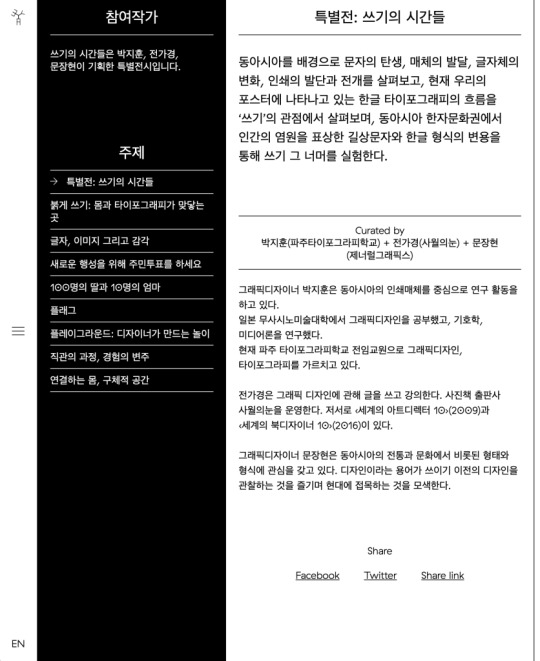
Fig 5.6: The 2017 site for Typojanchi, the Korean Typography Biennale, shows differing visual density in action. It is useful to compare translated websites like this to see how CSS styling can be standardized across Latin and CJK pages (https://ift.tt/2T2Emhi).
Text expansion factors
Expansion factors calculate how long strings of text will be in different languages. They use either a decimal (1.8) or a percentage (180%) to calculate the length of a text string in English versus a different language. Of course, letter-spacing depends on the actual word or phrase, but think of them as a very rough way to anticipate space for text when it gets translated.
Using expansion factors is best when planning for microcopy, calls to action, and menus, rather than long-form content like articles or blog posts that can freely expand down the page. The Salesforce Lightning Design System offers a detailed expansion-factor table to help designers roughly calculate space requirements for other languages in a UI (Fig 5.7).
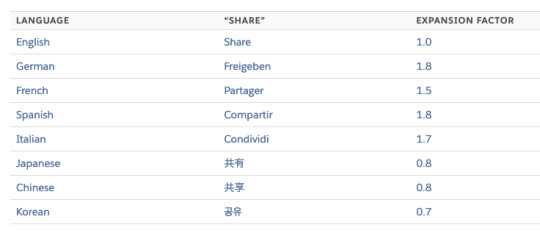
Fig 5.7: This expansion-factor table from Salesforce lets designers and developers estimate the amount of text that will exist in different languages. Though dependent on the actual words, such calculations can give you a benchmark to design with content in mind (http://bkaprt.com/ccd/05-12/).
But wait! Like everything in cross-cultural design, nothing is ever that simple. Japanese, for example, has three scripts: Kanji, for characters of Chinese origin, hiragana, for words and sounds that are not represented in kanji, and katakana, for words borrowed from other languages.
The follow button is a core part of the Twitter experience. It has six characters in English (“Follow”) and four in Japanese (フォロー), but the Japanese version is twenty percent longer because it is in katakana, and those characters take up more space than kanji (Fig 5.8). Expansion tables can struggle to accommodate the complex diversity of human scripts and languages, so don’t look to them as a one-stop or infallible solution.


Fig 5.8: On Twitter, expansion is clearly visible: the English “Follow” button text comes in at about 47 pixels wide, while the Japanese text comes in at 60 pixels wide.
Here are a few things you can do keep expansion factors in mind as you design:
Generate dummy text in different languages for your design comps. Of course, you should make sure your text doesn’t contain any unintentional swearwords or improper language, but tools like Foreign Ipsum are a good place to start getting your head around expansion factors (http://bkaprt.com/ccd/05-13/).
Leave extra space around buttons, menu items, and other microcopy. As well as being general good practice in responsive design, this allows you to account for how text in your target languages expands.
Make sure your components are expandable. Stay away from assigning a fixed width to your UI elements unless it’s unavoidable.
Let longer text strings wrap to a second line. Just ensure that text is aligned correctly and is easy to scan.
Cross-Cultural Design published first on https://deskbysnafu.tumblr.com/
0 notes
Text
Entering the West
The readings for today made very interesting points about the lack of success Korean artists have had in the U.S. While many of these cases occurred before the explosion that was Gangnam style and what now is BTS, a lot of these points may or may not apply to the current status of Korean pop in the states. When looking at media reviews about Korean pop idols these days, we see more of a positive response (this may be particularly because of the massive following behind these Korean idols) but also more groups are finding ways to become "popular" (refering to Hyunjoon's use of "sold out gig") in the states. When we look at the Korean artists touring in North America we may often find that the show is sold out. While Korean pop still remains a niche community in the West, we are seeing more of an interest in this highly commodified industry.
In the readings we see different reasonings to why other artists like BoA, Rain and Wonder Girls failed to enter the mainstream and many of these reasonings have to do with their presentation. Hyunjoon states that " something like Asianness or Koreanness, or any other national or regional root and scent, is never indispensable in the mass market of the pop music industry, which always prioritizes artists who have an ‘international’ repertoire. (516)" While I do partially agree with his comment on pop music being marketed as international with little to no immediate regional root, I have to argue that unfortunately Asian artists or "non-American" artists will always face the issue of being othered despite nearly erasing their national roots. I don't particularly agree nor understand the sentiment of erasing one's self for the sake of being globally recognized. We see artists like BTS embracing their Korean roots and further emphasizing their 'Koreanness' in their video IDOL that managed to further push the group into popularity. While BTS is a separate case from the entire Korean entertainment industry, it is still important to discuss their popularity and their decision to make their roots the center of this video/song.
youtube
In terms of the modern day I believe that Jung's argument of popular music having limits and those being less to do with language then with image gives America too good of an image. In 2017/ 2018 we saw an increase in foreign music becoming popular in the states with the help of artists like Luis Fonsi who found a new type of fame with his song Despacito. While Despacito is a Spanish song it was welcomed and made the most viewed video on YouTube. With this song you'd think that maybe foreign music would start to become welcomed in America, but then you see online comments showing that people are still reluctant to accept Korean music because it's in Korean and no one can understand or that it looks too weird. Whether it is the sound or the imagery it seems like either or both will always be a problem to Western audiences. (translations exist, and songs have English versions, it can be somewhat assumed that this whole ordeal really has to do with the lack of acceptance and stereotypes of Asian people).
In his reading Jung also brings up a good point about Asian Americans and their break into the music scene. He states that "Most Asian American hip-hop artists remain in underground music scenes, performing at smaller local venues and at Asian American festivals for Asian American communities. Those Asian pop artists who do flirt with more mainstream success often do so by entering through the hip-hop industry, since it has shown more flexibility, as evidenced by MC Jin's case" (231). This particular point reminded me of two artists from the U.S, one Seattle born Jay Park, CEO of 2 Korean music companies (AOMG and H1GHER Music), and who is now the first Asian to ever be signed to ROC Nation and LA based rapper Dumbfoundead. While these two artists have their differences and have had their struggles we do see that they both have derived from the known K-pop world and are attempting to break into the scene through Hip-hop. As Jay Park begins his career in the U.S., he has begun to see the struggle of an Asian male in this industry. Dumbfoundead on the other hand has mainly kept himself in America and done gigs (KoreaTown night market, College tours, and appearances at other Asian artists' shows) just as Jung mentioned.
youtube
youtube
Where this industry/genre will take these artists only time can tell. While we may not be able to predict the future of Korean pop and Korean artists in America we might be able to engage and witness the way that American opens itself to a new kind of artistry. One that mimics the established pop but also one that challenges the margins of what can become global.
0 notes